Dodging Coral Heads on the Caicos Bank
14/09/25 09:18
This time on Distant Shores we take you on a 3-day offshore passage from the British Virgin Islands to the Turks and Caicos Islands passing the Navidad and Silver Banks along the way. After making landfall at South Caicos, where we sample the local cuisine to celebrate, we tackle some shallow water piloting, dodging coral heads crossing the Caicos Bank, then stop to do some snorkelling. We conclude this leg of our Atlantic Circle with some fun at the main island of Providenciales, better known as Provo, famous for having some of the world's best beaches.
Comments
Sailing Back in Time
14/08/22 07:36
While work continues on our new aluminum Enksail Orion 49 sailboat, we take the opportunity to try our hand at sailing a traditional Dutch gaff-rigged sailboat and explore the Dutch Canals and Frisian Islands.
Custom Sailboat Design
04/12/21 08:47
This time on Distant Shores, we meet the design team and see preliminary drawings for Distant Shores 4, created by KM Yachtbuilders and Dykstra Naval Architects, based on our discussions.
During lockdown in Panama aboard Distant Shores 3, we began video calls with Eeuwe Kooi, owner of KM Yachtbuilders in the Netherlands, renowned for their aluminum sailboats. We’ve been doing a design feasibility study with him, outlining our criteria, listening to his suggestions, and looking at examples of other yachts KM have built with similar features.
Centreboard or Lifting Keel
02/10/21 08:01
Ever wondered about the pros and cons of a centreboard versus a vertical lifting keel? In this session of our design feasibility study with KM Yachtbuilders, we do a deep dive into keel options - how they operate, how each affects interior space and the importance of rudder depth. We consider a Bestevaer 53, look at features of a Stadtship 56 including telescoping rudders and study stability curves and polar diagrams.
Should we Build a Bigger Boat
04/09/21 07:42
We continue our design study for a 50-foot custom aluminium cruising boat with KM Yachtbuilders in the Netherlands who build Bestevaer and Stadship sailboats. In this session, we go over the details of a customized Bestevaer 49 and two Bestevaer 45's that KMY has built for other customers. All have features similar to the ones we're looking for and by the end we wonder if we should build a bigger boat.
KM Yachtbuilders Factory Tour
27/03/21 10:30
Ever wondered what it's like to build a custom aluminum cruising boat? Come along for a factory tour of KM Yachtbuilders in the Netherlands where we get an introduction to the aluminium boat building process as well as the many types and models of yachts KM Yachtbuilders manufacture, including custom-built yachts like Skip Novak's new Pelagic 77. We get an up-close look at how aluminum hulls are shaped, see the stages of build and consider the pros and cons of aluminum boats.
Buying a New Sailboat
12/12/20 07:57
Are you interested in buying or building a new boat but aren't sure where to begin? This video is the first in a new series about the design and build process of Distant Shores IV, the new custom-built aluminum e-boat we are planning to build. Determining criteria for your dream boat is the start of the process and Paul and his alter-egos, Traditional Paul and Future Tech Paul, hash out ideas together. Although entertaining, this video provides guidelines for determining important steps and considerations to help you make good decisions when searching for a new boat.
Varifold Propellor Review
26/10/19 19:57
We are exploring the Exuma Island group in the Bahamas. Such amazing water colours! We find a shallow place where we can put our Southerly 480 on the sand and try beaching her, then wait for low tide to dry out. We also review our propellor.
It's been over a year now and I was ready to review our Varifold folding propellor. This is the first folding propellor we've had and I have to say its extremely smooth. I think it's the smoothest when operated in forward of any prop we've had, with the least vibration. It's powerful and has work perfectly the whole time we've been testing it.
It's been over a year now and I was ready to review our Varifold folding propellor. This is the first folding propellor we've had and I have to say its extremely smooth. I think it's the smoothest when operated in forward of any prop we've had, with the least vibration. It's powerful and has work perfectly the whole time we've been testing it.
Where has all the water gone?
08/10/19 17:25
Exploring the shallows of the Exuma Islands near Staniel Cay we visit the Swimming Pigs and beach the boat on a sand bank in the middle of nowhere! Check out the YouTube below.
We also discuss the calculations for how to beach the boat safely. You need to figure the low tide and make sure there will be enough water at the next high tide to float again. In our case we plan to drop back to anchor for the night and it will be just after sunset so should be an easy operation.
We also discuss the calculations for how to beach the boat safely. You need to figure the low tide and make sure there will be enough water at the next high tide to float again. In our case we plan to drop back to anchor for the night and it will be just after sunset so should be an easy operation.
Aground! Shallow Water Piloting in the Bahamas
10/09/19 17:22
Many of you have been asking why we love variable-draft Southerly Yachts. After-all, we've owned three of the them throughout the 30 years we've been cruising. So in this latest video, we answer your questions, giving you our completely biased view on Southerlies :-) as we sail from the Turks and Caicos Islands to cruise the shallow seas of the Bahamas, before Hurricane Dorian hits. We sail in company with other 6 other Southerly Yacht owners and demonstrate the freedom the variable-draft keels give us to explore shoal-draft anchorages and bays that deeper draft yachts can't get gain access to.
At the same time, we share our techniques for shallow-draft piloting in the islands, no matter what your boat draws. The Bahamas is one of our very favourite cruising grounds and in this video we show you why.
At the same time, we share our techniques for shallow-draft piloting in the islands, no matter what your boat draws. The Bahamas is one of our very favourite cruising grounds and in this video we show you why.
We Moved Aboard a Catamaran
05/04/17 14:40
For the last 3 weeks we had an excellent time in the British Virgin Islands. We were doing our “Sail Away Weeks” where we had 4 couples a week aboard with us sailing in the fabulous BVI. Lovely Caribbean breezes were the norm, blowing as always from the east with sun and just a few showers. The notable exception was our second week which included an unseasonable 2-day gale gusting up over 35 knots! So overall we've sailed a catamaran in fair weather and foul… here's the story!
How did this all start? This winter we are "between boats" as we're still working on the new Distant Shores III. We decided it would be a great opportunity to restart our “Sail Away Weeks" having people aboard to give them a taste of the cruising life. And why not also give a catamaran a long-term test? Who knows? We might still decide to buy a catamaran?
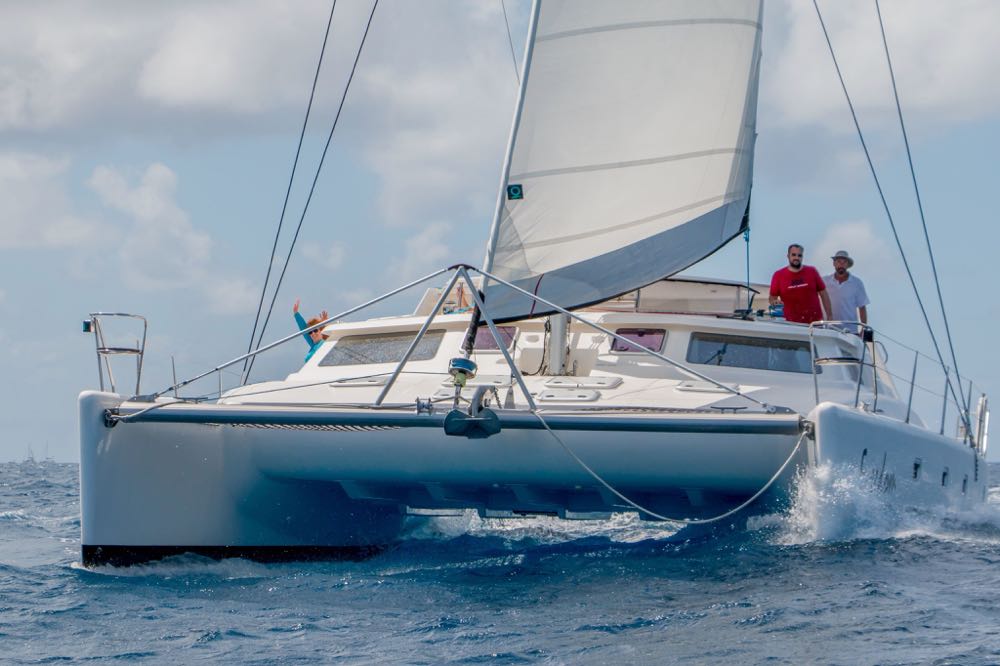
Here are some first impressions …
Tons of space! Big cabins (except for our "captain's cabin") large cockpit, spacious decks. The is a large boat! She is 27 feet wide!! Although there are 10 people aboard it’s not too crowded!

The catamaran sails upright but there is more wiggling than I imagined. The motion on this catamaran, a Voyage 500, is more confused and "quick" than on a monohull. Although the boat stays upright, not heeling, you feel each wave as it passes under each hull. So we tilt a bit as a wave picks up one hull then the next as it passes under us. I didn't have a problem with it but Sheryl found this a bit difficult to deal with in the galley.

From the picture below you can see the low bridge deck clearance that is to blame for the frequent banging as even smallish waves slap us around.
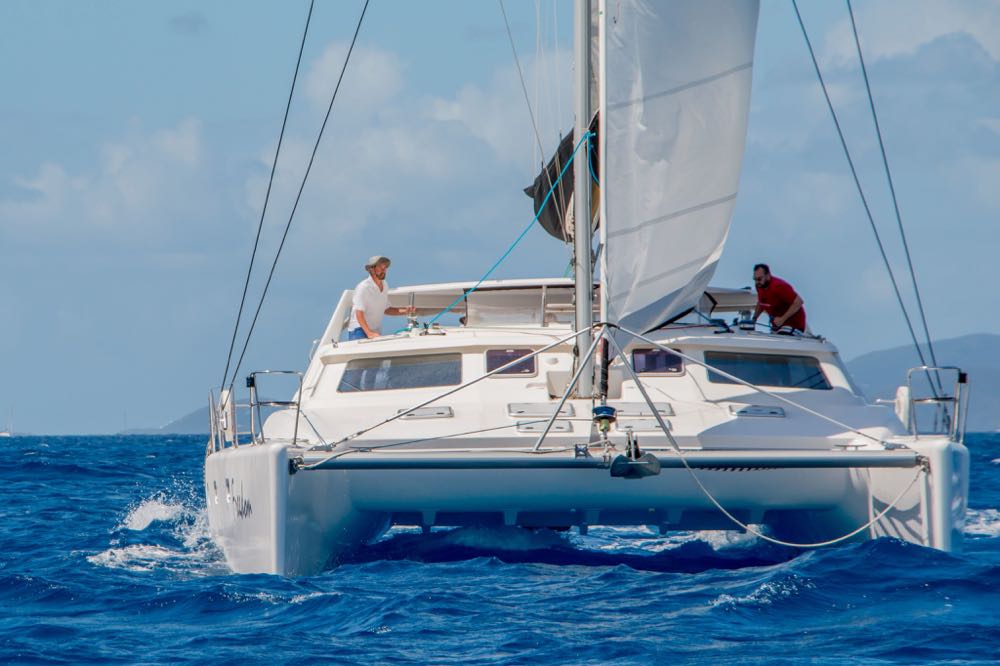
Luckily most of the time in the BVI you are reaching or beating, so it only affected us when we tried to return downwind to the base at the end of each week. If you're looking at purchasing a cat you'd need to test sail the boat with a screecher setup to see how it would work for you.
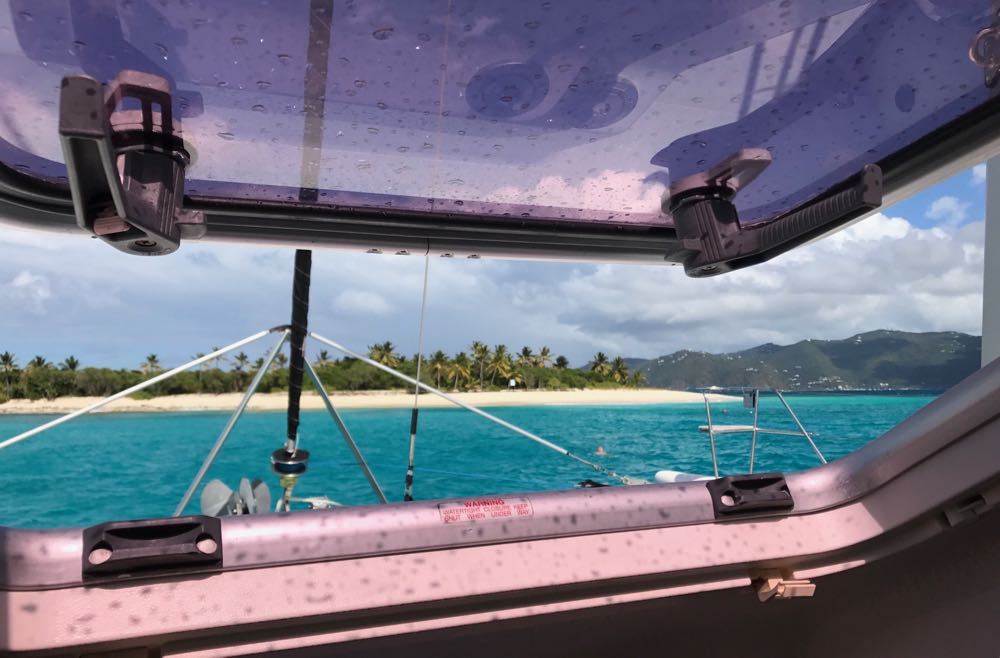
What do you think? Please comment below!
And here's a couple more views of the inside…

Galley Island with 3 bar stools (bolted down!)
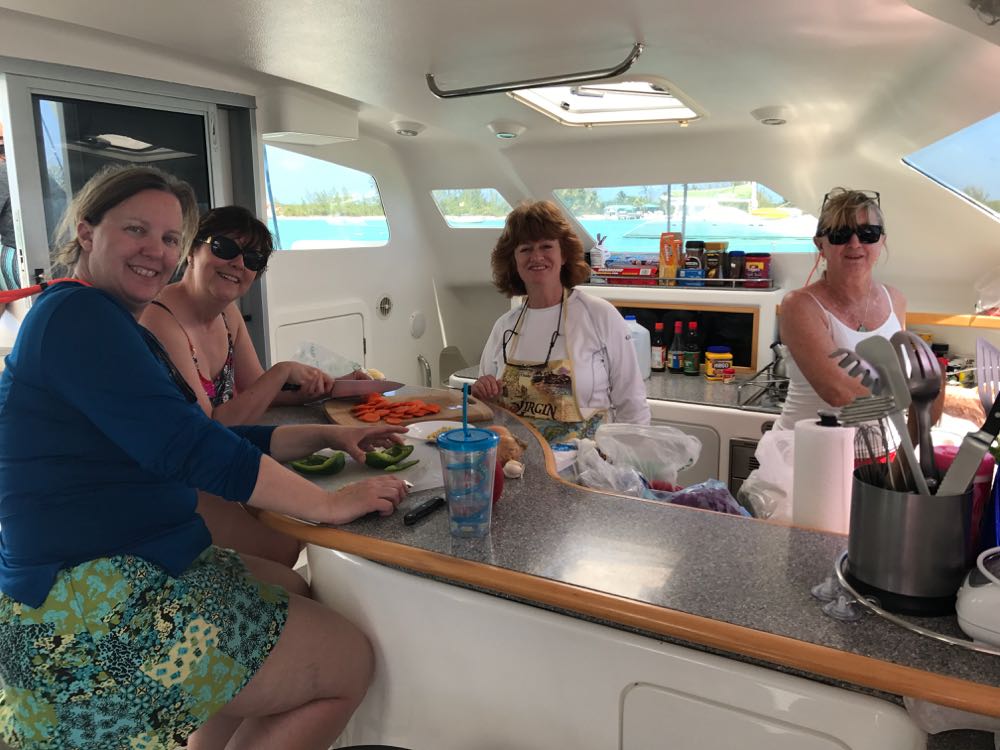
Galley…
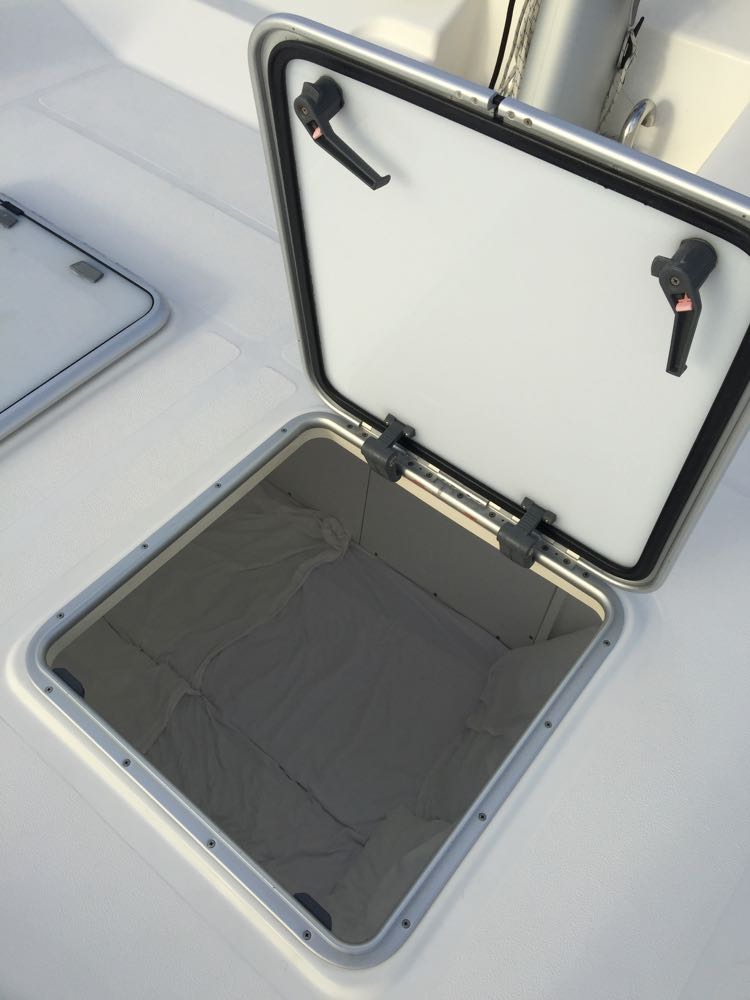
A view down into the "skipper's Cabin" which is actually an upholstered sail locker… yes you climb in through the hatch!
How did this all start? This winter we are "between boats" as we're still working on the new Distant Shores III. We decided it would be a great opportunity to restart our “Sail Away Weeks" having people aboard to give them a taste of the cruising life. And why not also give a catamaran a long-term test? Who knows? We might still decide to buy a catamaran?

Here are some first impressions …
Space, Wiggle and Bang!
Tons of space! Big cabins (except for our "captain's cabin") large cockpit, spacious decks. The is a large boat! She is 27 feet wide!! Although there are 10 people aboard it’s not too crowded!

The catamaran sails upright but there is more wiggling than I imagined. The motion on this catamaran, a Voyage 500, is more confused and "quick" than on a monohull. Although the boat stays upright, not heeling, you feel each wave as it passes under each hull. So we tilt a bit as a wave picks up one hull then the next as it passes under us. I didn't have a problem with it but Sheryl found this a bit difficult to deal with in the galley.

Banging!!
Wow this boat makes the most spectacular banging noise when a wave hits the bottom of the bridge deck! You can feel this in your feet standing in the saloon. Most of our guests didn't complain about the banging since we were only day sailing and no one was below sleeping while we sailed. Out in the cockpit it wasn't a big deal, but for a light sleeper like me?? On overnight passages it would be a deal-breaker for me…From the picture below you can see the low bridge deck clearance that is to blame for the frequent banging as even smallish waves slap us around.

Upwind performance
We managed to sail about 38-40 degrees off the apparent wind when sailing upwind. The sails on our boat appeared to be the original and were pretty tired. This Voyage 500 was built for the charter trade and comes with just a main and jib. Both sails were well built and had been maintained (more or less) but the boat is a 2008 model. I suspect the sails are that old as well. A newer main and jib might have allowed us to point better upwind.Downwind Sailing
Disappointing … the rig of this cat includes well swept spreaders. There is no backstay so the shrouds support the mast, but restrict the amount you can swing out the mainsail. Most owners would add an asymmetric spinnaker or a "screecher" sail on a furling unit and leave it set up on a bowsprit. The charter company doesn't do this but instead recommends you use the genoa downwind. This is quite a small sail and didn't give us very good performance. Even if we were able to lead the genoa sheet further outboard it would have been an improvement I think. This could easily be accomplished on an owner boat but I suppose for a charter they didn't want extra complications.Luckily most of the time in the BVI you are reaching or beating, so it only affected us when we tried to return downwind to the base at the end of each week. If you're looking at purchasing a cat you'd need to test sail the boat with a screecher setup to see how it would work for you.
Perfect BVI Boat?
If I seem to be complaining about the performance of the Voyage 500 - it’s not in relation to sailing her in the British Virgins! As a BVI charter boat she is great! 4 luxurious cabins for guests - each with its own head (bathroom/shower). Plenty of space for lounging around in the sun, and pretty decent sailing in the typical Caribbean trade-winds. She is a great choice for 4 couples sharing a week on a boat.
Is a Catamaran For You?
Of course only you can answer this question… catamarans offer so much living space and seem the perfect boat for Caribbean sailing, certainly in the British Virgins. But before you commit, it make sense to try one out on a longer offshore passage.What do you think? Please comment below!
And here's a couple more views of the inside…

Galley Island with 3 bar stools (bolted down!)

Galley…

A view down into the "skipper's Cabin" which is actually an upholstered sail locker… yes you climb in through the hatch!
How to Sail with a Swing Keel
15/02/17 17:17
Throughout our 27 years of international cruising, Sheryl and I have sailed over 100,000 nm and 40,000 of those miles have been sailed on the two lifting-keel yachts - Distant Shores, a Southerly 42 and Distant Shores II, a Southerly 49. Many people have asked what it is like to sail such a boat, how they sail upwind, what to do in storms, what happens if you hit the keel, what to do in huge waves and more.

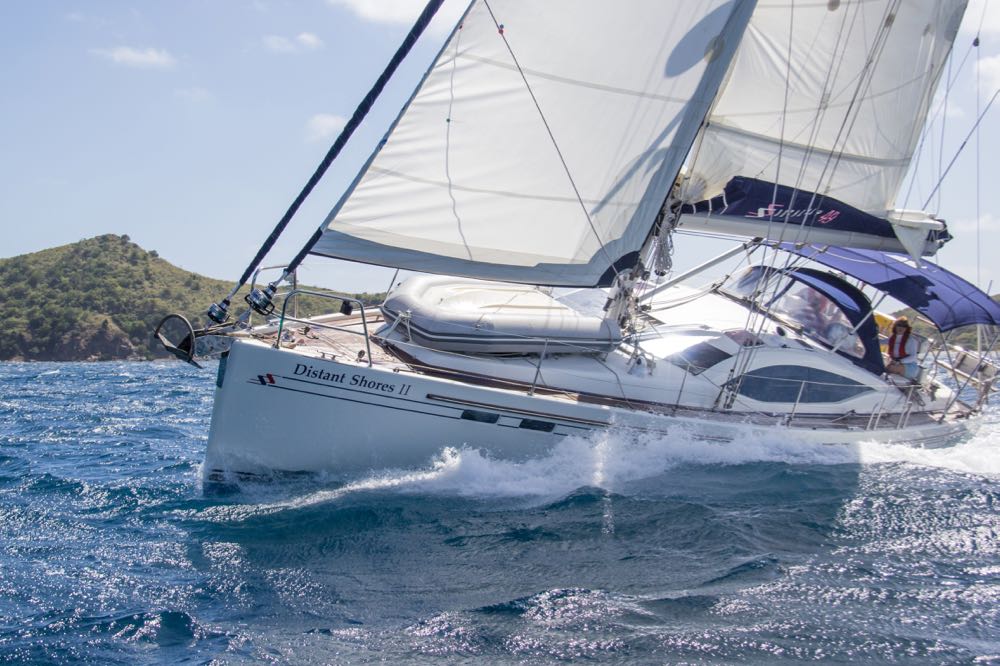
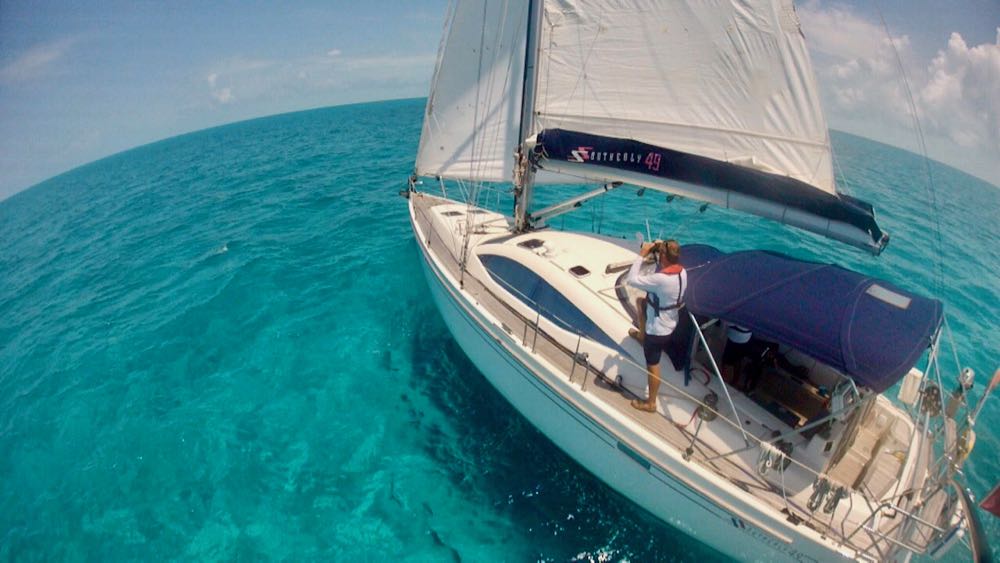
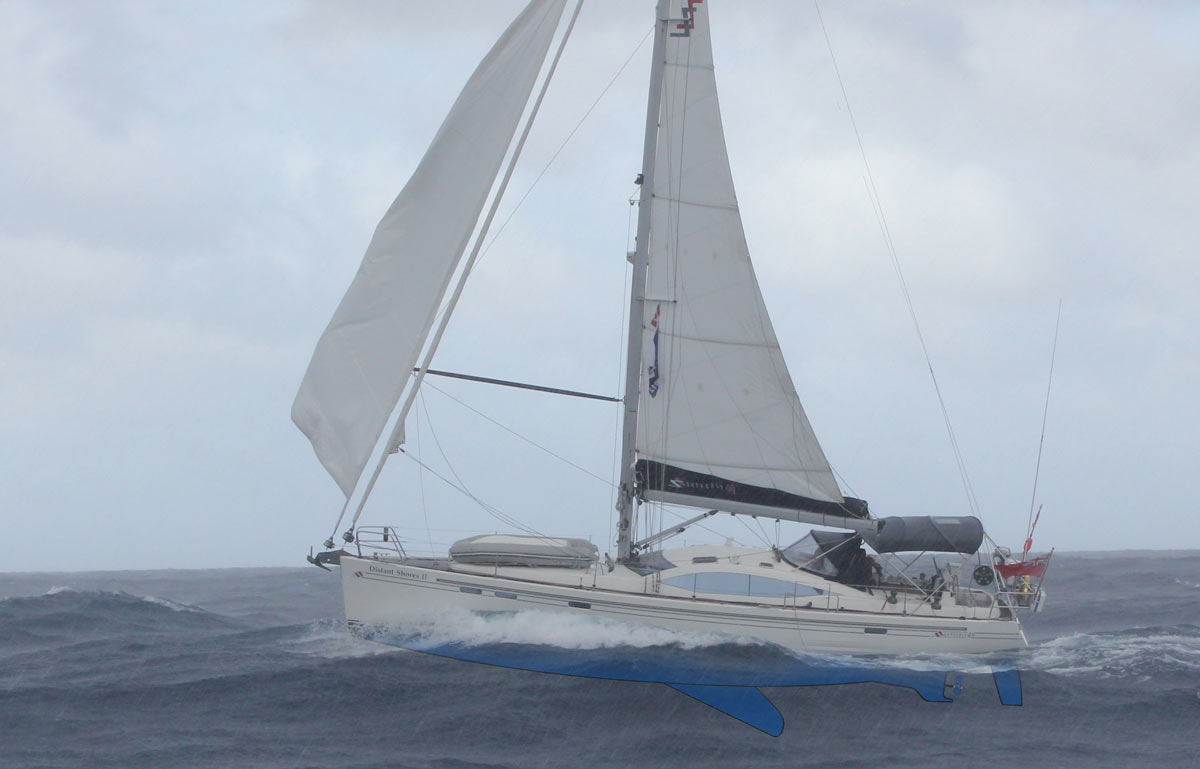
If you are considering buying a swing-keel yacht, please contact us for more information on the new Distant Shores III. She will have a swing keel just like Distant Shores and Distant Shores II and, based on our experience, she will be a great boat for a circumnavigation! We are currently working with a design team to develop this new model - to be launched later this year!
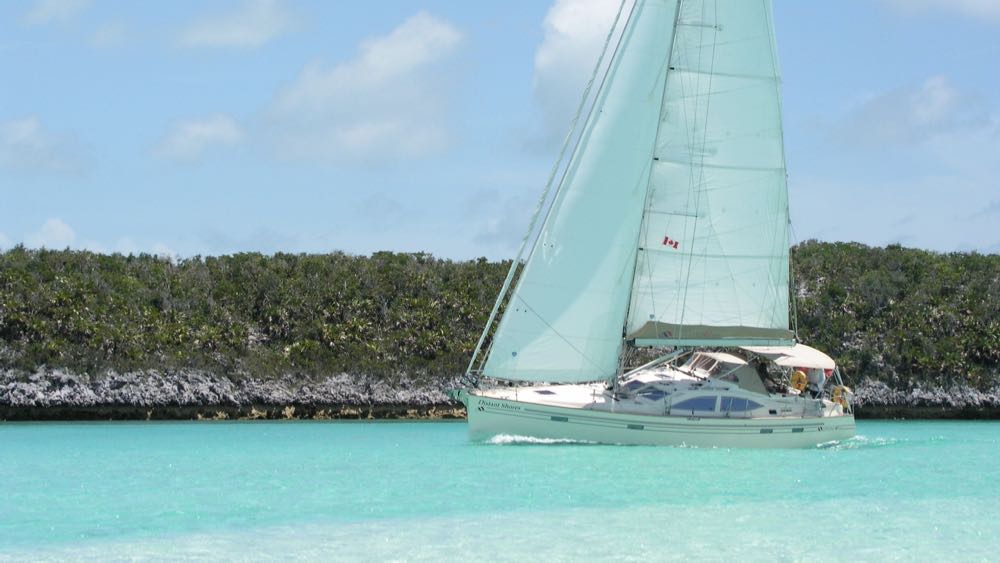
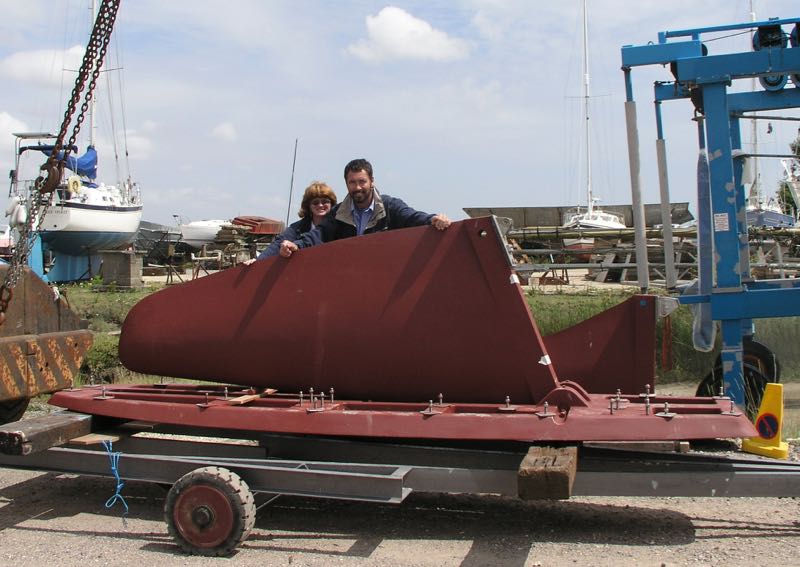

We're currently developing a new model of swinging keel shallow draft monohull. Distant Shores III be 48 feet long with a draft around 3' with the keel up. If you are in the market for a similar sailboat and would like more information please email us.
In an upcoming blog I will discuss how to sail a swing-keel yacht in heavy weather conditions…
Sailing Upwind
We always put the keel all the way down when working to windward. Our Southerly 49 draws 10' 3" (3.13m) with the keel down - an extremely deep aerofoil keel. Since the swing keel is also deeper than a conventional keel, it performs well upwind. The design doesn't carry as much weight deep down so the boats aren't as light or stiff as a racing boat, but they do well compared to a standard cruising boat with a moderate keel and offer many advantages to the cruising sailor. As you can see in the photo below, Southerly 49 keel at 10' 3" (3.13m) is a REALLY deep keel!
Aerofoil Keel Shape
Some centreboard boats have a flat board for a keel but the swing keels on the two Southerlys we've owned are both airfoil shaped and perform well upwind. I asked world-renowned yacht designer Rob Humphreys how important it was to have an aerofoil shaped keel. He said, "It’s vital, and not just for upwind performance. A well profiled aerofoil section keel optimizes the lift-drag ratio and widens the stall angle."
Sailing in Shallow Water
Whenever we are sailing in shallow water and there is a chance we might touch the bottom, we look over the chart and raise the keel to a comfortable depth. For example, when crossing the shallow Caicos Bank (photo below) we raise the keel halfway so we draw just 6-7 feet. The boat will still sail well, but she will not point as closely upwind. You can see we are close reaching. It is great to have this ability when exploring.
Broaching
Lifting the keel can reduce or eliminate the risk of the yacht broaching. According to cruising guru Jimmy Cornell, who owns a Garcia Exploration 45, "continuing to lift (the keel) up to the point where the board is fully retracted, is a great advantage as the risk of broaching is virtually eliminated. The absence of a keel to act as a pivot in a potential broaching situation means that the boat does not tend to round up when, in a similar situation, a keeled boat would do just that. It is a feature that I have blessed on many occasions and that has allowed me to continue keeping the spinnaker up longer than I would have done otherwise."Ocean Sailing Downwind
Before we sailed a Southerly Yacht across the ocean (we've now done it 5 times), I wondered what it would be like on a boat with a swing keel. Talking with other sailors who owned shallow-draft swing-keel yachts, I realized there were more options for sailing efficiently if you have a lifting keel. Swinging the keel up to raise it means you have actually moved the centre of lateral resistance backwards. It's possible to use this to your advantage when sailing downwind. Normally the yacht designer has carefully calculated the best position to mount a fixed keel. For a yacht with a swing keel, the design is done to optimize performance with the keel all the way down. When we swing the keel partially up, the centre of effort moves aft as you can see in the diagram below. We use this to improve performance when sailing downwind plus it reduces helm effort. It is similar to sailing a dinghy. With the keel most 70 percent raised, we have modified the bottom profile so the boat is more like an arrow. In this position the boat loves to sail downwind!
Distant Shores III
If you are considering buying a swing-keel yacht, please contact us for more information on the new Distant Shores III. She will have a swing keel just like Distant Shores and Distant Shores II and, based on our experience, she will be a great boat for a circumnavigation! We are currently working with a design team to develop this new model - to be launched later this year!
Swing Keel FAQ

Can you sail with the keel up?
Yes. The boat is safe to sail with the keel in any position including raised all the way up. Naturally the boat makes a lot of leeway when going to windward with the keel completely retracted, but she only heels a few more degrees. To understand this you can look at the image below of the keel for our Southerly 49 before it was installed during the build. The keel assembly consists of the massive grounding plate (weight 3180 kilos) plus the swinging keel at 2050 kilos. When you swing the keel up the centre of gravity does raise but not by enough to effect the safety or heeling by very much since so much of the ballast is in the grounding plate. In the picture above we have the keel of our Southerly 42 almost all the way up sailing the shallows of the Bahamas. We are drawing about 4.5 feet instead of our usual 9 feet (2.72m), the deepest draft of the Southerly 42. We are beating upwind and, despite making more leeway than usual, she still makes progress upwind.
What happens if you run aground?
The keel is designed to swing up into the hull when raised. Since it pivots on its front bearing in normal operation there is no damage if you hit something. Of course we try not to run aground, especially when moving at speed. The lifting pennant goes slack and the boat slows down. This is unlike a "vertically-lifting" centreboard which can be damaged by hitting something as the board jams in its case.
Does the board rattle?
We have never heard the keel move while sailing either of our Southerlys. We do not call it a centreboard since the weight and profile make it more like a regular keel. The swinging keel part of the assembly weighs 2050 kilos (4400 pounds) on the Southerly 49 which is about the same as a BMW 740 automobile! I don't think it could rattle. When we drop the keel down all the way it makes a thump as it comes to rest in the stops in the massive grounding plate.Does the keel require maintenance?
Yes. The keel lifting mechanism is a system and as such has a maintenance schedule. Once a year we check the hydraulic level, and every five years we replace the pennant that lifts the keel.Are you considering a Swing-Keel Sailboat?
We're currently developing a new model of swinging keel shallow draft monohull. Distant Shores III be 48 feet long with a draft around 3' with the keel up. If you are in the market for a similar sailboat and would like more information please email us.
In an upcoming blog I will discuss how to sail a swing-keel yacht in heavy weather conditions…